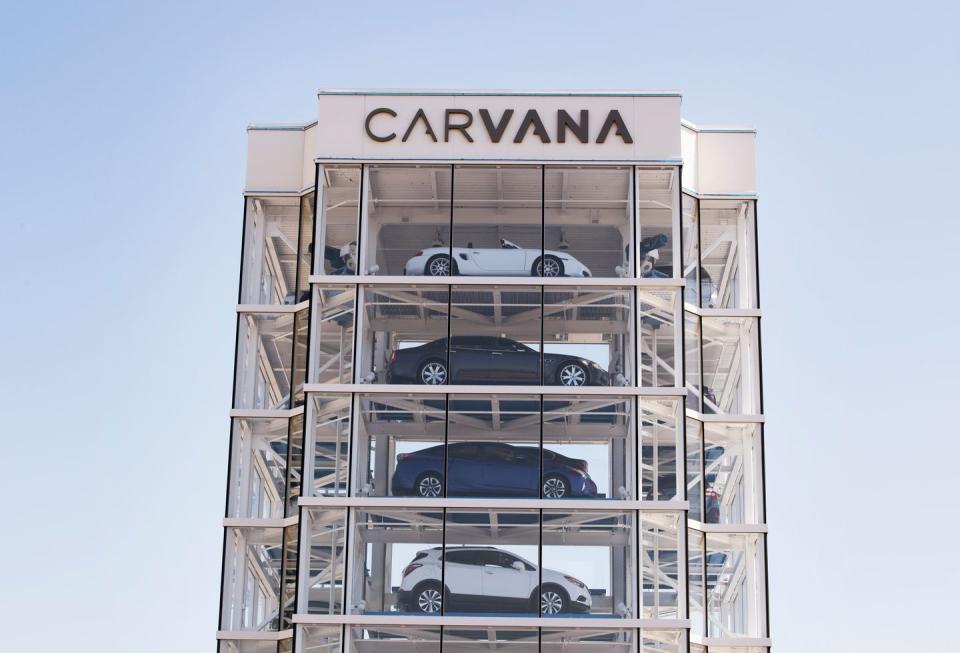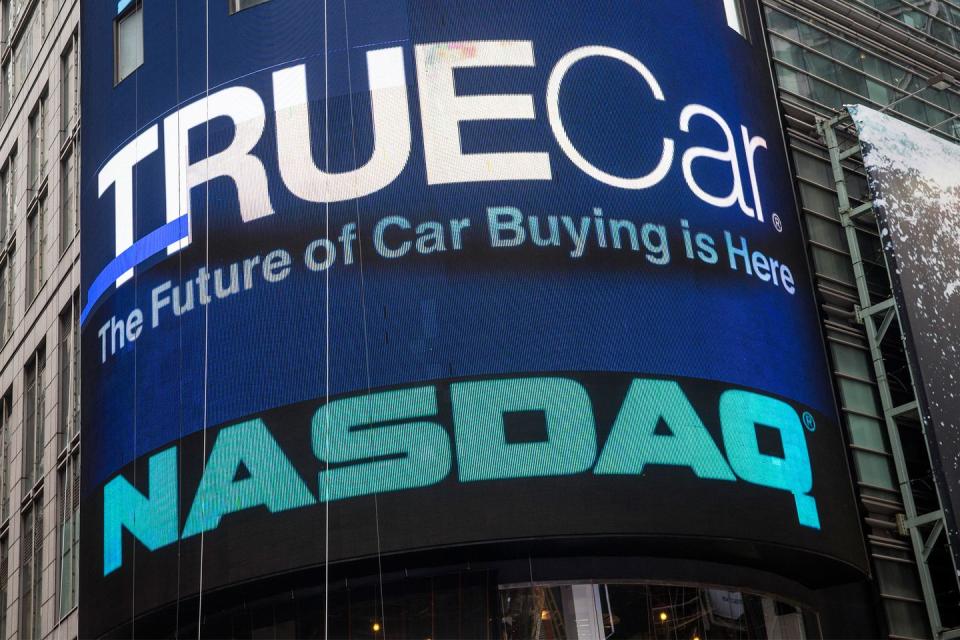Can the Carvana Retail Model Survive? Experts Say Yes

"Hearst Magazines and Yahoo may earn commission or revenue on some items through the links below."
Launched to disrupt the traditional dealership model, Carvana quickly climbed the ranks of online automotive retailers thanks to its upfront pricing and car delivery program.
Reaching its financial peak during the summer of 2021, the company is now in a nosedive, with its stock price dropping by hundreds of dollars and its quarterly reports showing $500 million in losses.
While the demise of Carvana seems imminent, industry experts say the overall company model is one that could succeed in the future, if the right parameters are met.
Once touted as the Amazon of used cars, online retailer Carvana seems to be nearing the end of its formerly successful existence. After posting $400-500 million losses in each quarter this year, the company's stock has been in a free fall without so much as a parachute to slow it down. Additionally, the company has cut 4000 jobs this year, citing concerns over slowing used car sales. With an abundance of inventory, rising interest rates, and record losses, Wall Street analysts are saying Carvana's collapse may be imminent.
But it wasn't always this way. In fact, Carvana was once churning used cars in and out, operating with a simultaneously flowing stream of revenue and inventory. Specifically, Q3 of 2021 showed its first profit, reaching an all-time high share price of $370 and receiving a $63 billion valuation. In theory, that gave Carvana a higher valuation than Ford.

Furthermore, the company was breaking down the barrier of how the industry viewed online car buying. Founded in 2012, Carvana and other dealership-style online services like Vroom or CarsDirect were disruptors in a conformist market. Previously reserved for those brave enough to buy a Craigslist special, online car buying now had the organization of a traditional dealership purchase—financing, delivery, and service included.
If the business model was popular with consumers and had proven itself to be profitable, how did it go so wrong? Diana Lee, co-founder and CEO of Constellation and a former automotive brand consultant, says it's a result of the kind of inventory accumulation that the Carvana model was built on.
Marketed as a painless way to get an instant online offer, Carvana became notorious for carrying through with its online offers, regularly buying copious numbers of used cars from consumers at record prices. When the markets were hot, these units were immediately sold to another consumer in a matter of days or even hours, Lee explained.
"Now, with the interest rates going up and demand falling, they're stuck with these vehicles at record prices," said Lee in an interview with Autoweek. "They don't own these vehicles—they're paying an interest rate for every car that they're holding on to. It's a float of that vehicle, and the float doesn't get paid until they actually make a transaction and sell those vehicles."

This floating finance method of buying and selling cars is common within the dealership realm, but Carvana's fatal mistake was likely in its rapid acquisition of inventory combined with its interest rates nearly doubling. Lee, who previously worked at dealerships and as a business development manager for Ford and General Motors, said the golden rule of the automotive sales industry is to never hold onto a car longer than 60 days.
Past that point, the amount of interest paid and depreciation onset makes selling the car a rarely profitable endeavor. In Carvana's case, its attempt to rival the inventory of traditional dealerships during industry-wide limits on availability means it now has too many cars and too few buyers.

In fairness to Carvana, there was a time when buying excess inventory was paying handsomely. As computer chip shortages surged, traditional brand-based dealership inventory was debilitated and both new and used cars were selling for record high prices at lofty interest rates as demand soared. But this economy of surplus cash couldn't last forever. Inflation has taken its toll on average consumers and businesses in different ways, and Carvana was caught in the middle of a bad storm, Lee explained.
Additionally, Carvana's loan methodology is partially to blame. In fact, a Wall Street Journal article called the company's financing practices risky back in 2021, even at the height of the company's profitability.
"When Carvana makes a car loan to a buyer, it packages it with other loans and sells the debt to investors," wrote Wall Street Journal reporters Kristin Broughton and Margot Patrick. "While other auto lenders also sell loans to investors, they typically keep the debt on their books, recording gains and losses over time. Carvana, on the other hand, doesn’t retain the debt and immediately books gains on the cash sales."
While this method gives the company an instant injection of cash, it can also waver investors should the economy change. This is exactly what has happened to Carvana as of late. The company's CEO, Ernest Garcia III, has fallen back on cost-cutting measures in recent addresses to investors, saying he plans to leverage both $4 billion in liquidity and $316 million in cash assets as well as $2 billion in real estate properties to weather this storm. Whether or not this is possible is yet to be seen, but where does this leave the state of online automotive retail?

Regardless of Carvana's fate, online car buying is now a facet of the automotive landscape. From a consumer perspective, Carvana provided a largely painless experience thanks to its price transparency and maximum transaction efficiency, excelling at the two facets that consumer data shows as common friction points in the car buying or selling process. Additionally, online services like Markup.org and TrueCar have proven to be powerful tools in fighting markups and finding fair prices from the right dealerships.
"TrueCar was founded on this notion of price transparency and making it very easy for consumers to find the right price for the car," said TrueCar's Head of Product Rich DiStefano in an interview with Autoweek. "I've been in this marketplace where consumers are wanting to do more things on their terms and have less variability and more certainty about the things that we're interacting with."
Founded in 2005, TrueCar is an online service that allows consumers to shop for vehicles by providing detailed pricing information and connecting shoppers with a network of 13,000 TrueCar-partnered dealers. Typically, a large portion of these transactions could be done online, though the final purchase was often done in person. However, in light of a shifting market, TrueCar launched its own online marketplace called TrueCar+ back in March.

Originally started as a pilot program in Tampa, Florida, the online marketplace connected buyers with specific dealerships that could accommodate a 100% online transaction.
TrueCar+ has now expanded to Alabama, Georgia, North Carolina, South Carolina, and Tennessee, in the hopes of widening its reach for both new and used vehicle sales. Notably, TrueCar's website does offer a sell-your-car feature, though the vehicle is ultimately purchased by one of its verified dealerships.
That is to say, these online models are not without merit. TrueCar claims 62% of buyers are somewhat or extremely likely to complete their vehicle purchase transaction online, and post-purchase surveys from CDK Global show that Generation Z car buyers typically spent around 17 hours shopping online prior to finalizing a purchase in-store. To Diana Lee, this makes a lot of sense.
"The franchise model lost a lot of business to data aggregators, such as Carvana and TrueCar," she said. "A lot of the dealer communities out there were very much opposed to giving numbers up front. I think the consumer market still wants that transparency; they want to know how much it's going to cost; they want to know whether you have it in stock; and they want to know if it's close enough that they can go pick it up."

While in-person car buying can be exhausting and abrasive, buying online also has downsides that internet retailers will need to address going forward. For one, having a relationship with the service and parts department is essential for successful vehicle ownership, whether it was purchased from the connected dealership or not.
Additionally, continuing to offer in-person services will be important for customers who don't feel comfortable completing large transactions online. And some manufacturers are considering direct-to-consumer sales, potentially cutting out the market share of new cars to be sold online. Even so, many states have consumer protection regulations on what constitutes a true dealership, as direct-to-consumer brands like Lucid have been barred from selling in states like Texas.
Despite these challenges and an uncertain market, writing off the model that Carvana built would be shortsighted. With the right conditions, it's clear the framework can lead to commercial success and satisfied consumers. Retaining loan debt, making a truce with state regulators, and staying on the more prudent side of big waves of supply and demand could possibly make this method a sustainable fixture of the automotive landscape for years to come.
It's the end of Carvana as we know it and the beginning of the future of car buying.
Would you consider buying a car 100% online? Tell us why or why not in the comments below.

 Yahoo Autos
Yahoo Autos 